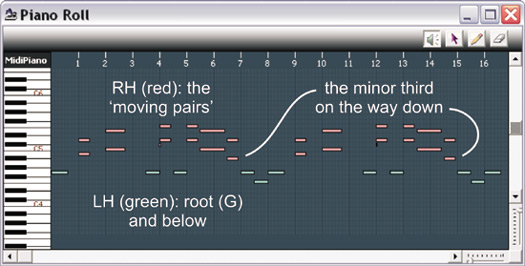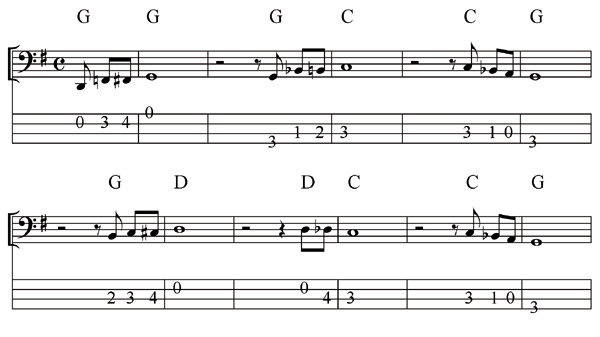Musicarta Twelve-bar Piano Styles
Moving Pair - Module Eleven
More Three-plus-one variations
Musicarta’s Moving Pair series isn’t about reproducing historic performances or copying licks. Rather, the aim is to teach the basics of twelve-bar riffs and combine them at the keyboard in a satisfying and exciting way. The more times you combine and recombine the elements like this, the easier it becomes to create another riff or work out how a recorded example is put together.
Note: Both the riffs in this module are played ‘double time’ – there are two bars of music (eight crotchet beats) for each chord symbol in the chord charts. Technically, they are ‘24-bar twelve-bars’. See also the note in Module Nine.
First module riff
There are two riffs in this module. Here is the first riff we’re building up to.
A two-handed version
The first module riff uses this chord sequence.

Try playing this riff with two hands first.
Play the root(s) and any notes below with the left hand and the moving pair material with the right hand. The MIDI performance file played on MidiPiano clearly shows the hands divided this way.
All the crushed notes are optional! Don’t let not being able to play crushed notes to your complete satisfaction ruin your enjoyment or slow down your progress.
You hear something slightly different in the first module riff. It uses the minor third (B¨ in the G position, E¨ in the C position) at the end of the main G and C patterns. The MidiPiano performance shows you this clearly if you can’t work it out just by ear – zoom in to just one pattern and slow the playback down for a good look-and-listen.

(The riff sounds fine without this extra twist, though, so it doesn’t matter if you leave it out for now.)
The one-bar D and C patterns in the third line of the chord chart (bars 9 and 10) have a different pattern, but it’s still classic moving pair material. You should be able to get it, with the help of the MIDI file performance
(These two bars are also slightly different to each other. Optionally , look-and-listen closely to the audio and MidiPiano performances to work out how.)
Use your media player and MidiPiano (or other sequencer) intelligently to help you get this riff. Zoom in, slow down and be prepared to practice over and over until you get it.
Fingering a single-handed version
If you’re playing in a combo, you might be quite happy with just the two-handed version. Otherwise, you’ll want to learn to play the moving pair material with just the right hand, and adding the bass in the left. This involves a closer look at fingering.
Here’s the riff in G with fingering. NB: You don’t need to be able to read music to follow! The right hand thumb – finger 1 – is on G, and the rest of the notes are predictable ‘moving pair material’.

The clever part is putting RH 4 and 1 on the middle pair on the way down, and passing 3 and 2 over them, in turn. It’s a strange feeling that takes some getting used to, but it’s smooth and gets you back down to thumb on G.
Try it, see how it works and why. You could use 4-2 on the E-C pair, but sooner or later, we all have to get to grips and learn some tricks!
The riff should still sound exactly the same played with one hand.
Fingering
We study fingering so we can play the music we want to hear – NOT because somebody tells us to!
Here are two ‘good fingering’ principles.
- You want to be able play as many notes as possible notes legato, that is, linked up, smoothly – without running out of fingers and having to ‘hop’.
- You often work out fingering backwards, from where you want to be - in this case, have the right hand thumb free and ready to play the note G.
The bass line
The bass line here is a development of the Module Ten riff bass line. Revise these three groups of three notes.

The new development is a note squeezed in between seventh and the root.

The new note is a major seventh – a semitone below the root. Listen to the full riff again, paying close attention to the bass line.
The three-note run-up has to start in time
to arrive at the root (R) on the strong beat at the start of the bar. Listen to this practice drill.
These performance demo files use a slightly different chord sequence:

(Remember, each cell in the chord chart is worth eight counts.)
Developing the bass line
You could, in theory, play the same run-up to every start-of-the-bar root.
But varying ('tweaking') a mechanical pattern usually improves the overall impression. Listen to the first module riff audio again.
There are actually four different run-ups between the various chords. Here they are, written out with bass guitar TAB.

Playing hands together
Look (listen) closely to see ‘what comes together’ when both the left hand and the right hand are playing at the same time.

You actually have an F sharp and an F natural playing at the same time. If you’re practising very slowly this will sound ‘wrong’, but at performance speed a bit of dissonance like this adds character.
If you’re having difficulty at any particular spot, pause and zoom in on the MidiPiano MIDI performance for a closer look.
Second module riff
The second riff in this module is very similar to the previous riff, but:
- the ‘in-between note’ (major seventh) in the bass line run-up is gone, and
- the right hand only comes in on the middle moving pair.
This similar-but-different riff therefore offers an exercise in quickly ‘getting’ a rhythmic variation.
Listen to the riff audio.
The riff uses the same chord sequence as before.

Here’s the riff G position looped and slowed down to practice speed.
Disregard as much of the bass line as you want – you could just play the one long bass note for now.
The left hand
The riff uses the ‘flapping thumb’ left hand from previous Moving Pair modules (here on its own, without the run-up).
It’s an irresistible beat – well worth practising!
The C and D patterns
The second module riff actually uses the C and D patterns from first riff (bars 9 and 10), but, as an advanced exercise, you could try transposing the second module riff pattern into C and D as well, for those bars. It would sound like this:
You might find this transposing exercise easier than you think!
Playing hands together
Here’s the written-out music for the riff G position, for the fingering, and to see which left and right hand notes go together.

The fingering shows that you are pulling the second finger off the black key onto the next-door white key for the slowed-down crushed note.
Going on from here
This is the end of the Musicarta Moving Pair series of twelve-bar piano lessons.
The Moving Pair material is incredibly versatile. Listen to this audio sketch:
It’s all Moving Pair material with the right hand playing various ‘two positions only’ inversions on this chord sequence.
It’s not hard music to play – you will quickly pick up the chords from the MIDI file. ‘Giving yourself permission’ to have a go is often the main thing stopping keyboard players making riffs like this up.
From here, you will probably want to browse the members-only learning material for the other Musicarta Twelve-bar modules showcased on the Twelve-bar Styles portal page and the Mister Musicarta YouTube Twelve-bar playlist.
You might like to try playing some of the twelve-bar solos you’ll find there by ear, and you are probably capable of playing along with a host of blues, rock’n’roll, and generally any twelve-bar-based pop music. Review the section in Module Eight on how to use MidiPiano to ‘tune in’ to the key of your ‘target music’ so you can start applying your Moving Pair expertise.
|
OUT NOW! |
THE MUSICARTA BEAT & RHYTHM WORKBOOK At last! An effective approach to keyboard rhythm & syncopation skills. Learn more! |
ONLY $24.95! |
TWELVE-BAR |
The MusicartaA methodical approach to keyboard syncopation for
|
PUBLICATIONS
exciting keyboard
creativity courses
CHORDS 101
WORKBOOK

~HANON~
video course

Musicarta
Patreon
PENTATONICS
WORKBOOK
video course

Creative Keyboard
video course

BEAT AND RHYTHM
WORKBOOK

- Volume 1 -

12-BAR PIANO
STYLES WORKBOOK

MUSICARTA MODES
WORKBOOK

PIANO STYLE

CANON PROJECT
video course

VARIATIONS
video course


- Piano Solo -
video course

- Piano Solo -


YouTube playlists





 THE LOGO
THE LOGO
